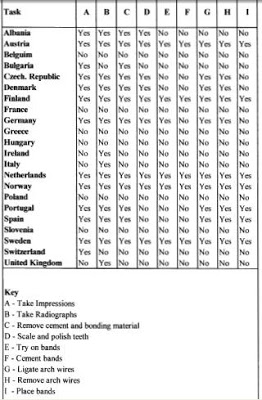Odontologia

- Comparative Study Among Dentistry Undergraduates And Forensic Odontology Postgraduate Students Through Smile Photographs For Human Identification
Abstract. Introduction: The execution of forensic odontology technique for human identification depends on the existence of dental files produced ante-mortem (dental records, clinical notes, radiographs or dental casts). However, when...
- Perception Of Orthodontists Regarding The Management Of Root Resorption – Clinical And Legal Aspects
Abstract Aim: To evaluate the management adopted by orthodontists regarding root resorption caused by orthodontic treatment, relating it to their time of experience and the applicable legal norms. Methods: the study population consisted of 56...
- Human Identification Based On Cranial Computed Tomography Scan — A Case Report
Abstract.Today, there is increasing use of CT scanning on a clinical basis, aiding in the diagnosis of diseases or injuries. This exam also provides important information that allows identification of individuals. This paper reports the use of a CT scan...
- The Forensic Odontologists Association Of South America (a.o.f.s.)
Criação da Associação Sulamericana de odontolegistas (AOFS) The Argentinian Society of Legal Odontology (S.A.D.O.L.) was founded in year 1977 in the city of Rosario, province of Santa Fe, Argentina. Its first president was a physician called Oscar...
- Journal Of Forensic And Legal Medicine
The Journal of Forensic and Legal Medicine provides a forum for the rapid publication of topical articles on legal medicine and all clinical aspects of forensic medicine and related specialities. The Journal carries definitive reviews, original communications,...
Odontologia
A Survey of the Delegation of Orthodontic Tasks and the Training of Chairside Support Staff in 22 European Countries
Abstract
This paper reports on a survey which was undertaken to investigate the delegation of orthodontic tasks and the training of chairside support staff in Europe. Two questionnaires were posted to all members of the EURO-QUAL BIOMED II project together with an explanatory letter. The first dealt with the delegation of nine clinical tasks during orthodontic treatment. The second with the types of chairside assistant employed in each country and the training that they are given. Completed questionnaires, which were subsequently validated, were returned by orthodontists from 22 countries. They indicated that there was no delegation of clinical tasks in six of the 22 countries and delegation of all nine tasks in five countries. The most commonly delegated tasks were taking radiographs (in 14 of the 22 countries) and taking impressions (in 13 of the 22 countries). The least commonly delegated tasks were cementing bands (in five of the 22 countries) and trying on bands (in six of the 22 countries). Seven of the 22 countries provided chairside assistants with training in some clinical orthodontic tasks. Eighteen of the 22 countries provided general training for chairside assistants and offered a qualification for chairside assistants. Four of these 18 countries reported that they only employed qualified chairside assistants. Of the four countries which reported that they did not provide a qualification for chairside assistants, two indicated that they employed chairside assistants with no formal training and two that they did not employ chairside assistants. It was concluded that there were wide variations within Europe as far as the training and employment of chairside assistants, with or without formal qualifications, and in the delegation of clinical orthodontic tasks to auxiliaries was concerned. Article published in: J Orthod. 2000 Sep;27(3):279-82.
Download full text.
loading...
- Comparative Study Among Dentistry Undergraduates And Forensic Odontology Postgraduate Students Through Smile Photographs For Human Identification
Abstract. Introduction: The execution of forensic odontology technique for human identification depends on the existence of dental files produced ante-mortem (dental records, clinical notes, radiographs or dental casts). However, when...
- Perception Of Orthodontists Regarding The Management Of Root Resorption – Clinical And Legal Aspects
Abstract Aim: To evaluate the management adopted by orthodontists regarding root resorption caused by orthodontic treatment, relating it to their time of experience and the applicable legal norms. Methods: the study population consisted of 56...
- Human Identification Based On Cranial Computed Tomography Scan — A Case Report
Abstract.Today, there is increasing use of CT scanning on a clinical basis, aiding in the diagnosis of diseases or injuries. This exam also provides important information that allows identification of individuals. This paper reports the use of a CT scan...
- The Forensic Odontologists Association Of South America (a.o.f.s.)
Criação da Associação Sulamericana de odontolegistas (AOFS) The Argentinian Society of Legal Odontology (S.A.D.O.L.) was founded in year 1977 in the city of Rosario, province of Santa Fe, Argentina. Its first president was a physician called Oscar...
- Journal Of Forensic And Legal Medicine
The Journal of Forensic and Legal Medicine provides a forum for the rapid publication of topical articles on legal medicine and all clinical aspects of forensic medicine and related specialities. The Journal carries definitive reviews, original communications,...
